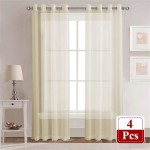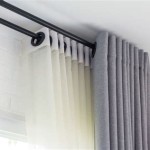Living Room Curtains for Brown Furniture: A Comprehensive Guide
Selecting curtains for a living room featuring brown furniture requires careful consideration of various factors to achieve a cohesive and aesthetically pleasing space. The color and tone of the brown furniture, the existing wall color, the desired ambiance, and the amount of natural light entering the room all play crucial roles in determining the ideal curtain choice. This article provides a comprehensive guide to navigating the options and making informed decisions when selecting curtains to complement brown furniture.
Understanding the Nuances of Brown Furniture and Color Theory
Brown is a versatile yet complex color that exists in a wide spectrum of shades, from light beige-browns to deep, rich chocolates. The undertones within the brown hue significantly influence the curtain color selection. Brown furniture can lean towards warm (red, orange, yellow) or cool (gray, green, blue) undertones. Identifying these undertones is the first step in creating a harmonious color palette.
Color theory provides a framework for understanding how colors interact with each other. Complementary colors, located opposite each other on the color wheel, create a vibrant and contrasting effect. Analogous colors, situated next to each other, offer a more harmonious and subtle blend. Triadic color schemes involve three colors equally spaced on the color wheel, providing a balanced and dynamic aesthetic. When selecting curtains for a room with brown furniture, consider how different color schemes will impact the overall visual appeal.
For example, if the brown furniture has warm undertones, curtains in shades of blue or green (complementary and analogous colors, respectively) can offer a striking contrast or a calming harmony. Conversely, if the furniture has cool undertones, warm colors like oranges, yellows, and reds, in muted or deep tones, can introduce warmth and balance the coolness of the brown.
Key Considerations for Curtain Color Selection
Beyond color theory, several practical considerations influence curtain color choice. The existing wall color is a primary factor. If the walls are neutral (white, gray, beige), the curtain options are significantly broader. However, if the walls are already a strong color, the curtains should either complement or contrast in a carefully considered manner.
The amount of natural light the room receives also dictates the appropriate curtain color and opacity. Darker curtains can create a cozy and intimate atmosphere, but they may also make the room feel smaller and less bright. Lighter-colored curtains, on the other hand, allow more light to filter through, creating a brighter and more airy feel. In rooms with limited natural light, sheer or semi-sheer curtains in light colors are often the best choice.
The desired room ambiance should also be taken into account. If the goal is to create a relaxing and calming space, softer, muted colors like blues, greens, and grays are suitable. If a more energetic and vibrant atmosphere is desired, bolder colors like reds, oranges, and yellows can be incorporated. However, it's crucial to use bold colors judiciously to avoid overwhelming the space.
Think about the overall style of the room. Is it modern, traditional, bohemian, or eclectic? The curtain color and fabric should align with the existing decor to create a unified and cohesive look. For example, linen or cotton curtains in neutral colors would suit a farmhouse or minimalist style, while velvet or silk curtains in rich colors would complement a more traditional or luxurious aesthetic.
Popular Curtain Color Options for Brown Furniture
Several curtain colors consistently work well with brown furniture due to their inherent compatibility and versatility. These options provide a starting point for exploring different color palettes and finding the perfect match for a specific room.
Neutrals: Neutral curtains, such as white, off-white, beige, gray, and greige (a combination of gray and beige), are always a safe and reliable choice. They provide a clean and sophisticated backdrop that allows the brown furniture to take center stage. These colors also offer excellent flexibility in terms of adding pops of color through accessories like pillows, rugs, and artwork. Different shades of neutral can be used to create subtle contrasts and depth within the room. For example, crisp white curtains can brighten up a room with dark brown furniture, while a sophisticated greige can create a softer, more muted effect.
Blues: Various shades of blue, from light sky blue to deep navy blue, complement brown furniture beautifully. Blue is a calming and versatile color that creates a sense of serenity and sophistication. Light blues can brighten up a room and create a fresh, airy feel, while darker blues can add depth and drama. The specific shade of blue chosen should be based on the undertones of the brown furniture and the desired ambiance of the room. For example, a warm brown sofa might pair well with a slightly muted, dusty blue, while a cool brown leather chair could be enhanced by a bolder navy blue.
Greens: Green is another excellent choice for curtains in a room with brown furniture. Similar to blue, green evokes a sense of nature and tranquility. Different shades of green, from light sage green to deep emerald green, can create a variety of moods. Light greens can create a fresh and airy feel, while darker greens can add depth and richness. Green also pairs well with a variety of other colors, making it a versatile option for creating a cohesive color palette. Consider the specific shade of green in relation to the wall color and other accents in the room.
Yellows: Yellow can add warmth and brightness to a room with brown furniture. However, yellow should be used with caution, as it can be overpowering if not used correctly. Muted yellows, such as mustard yellow or ochre, are often a better choice than bright, saturated yellows, as they are less likely to overwhelm the space. Yellow curtains can also work well when paired with other neutral colors, such as white or gray. The key is to find a shade of yellow that complements the brown furniture and the overall style of the room. Consider a patterned curtain that incorporates yellow with other complementary colors to soften the impact of pure yellow.
Reds and Oranges: While bolder choices, reds and oranges can work beautifully with brown furniture if used carefully. Deep reds, like burgundy or maroon, can create a luxurious and sophisticated feel, while muted oranges, like terracotta or burnt orange, can add warmth and earthiness. These colors are best used in rooms with ample natural light, as they can make a room feel smaller and darker if the light is limited. It's also important to balance these bolder colors with neutral accents to prevent the room from feeling overwhelming. Think about using these colors in patterned curtains with a neutral background.
Fabric, Texture, and Pattern Considerations
Beyond color, the fabric, texture, and pattern of the curtains also play a significant role in the overall aesthetic. The fabric should be chosen based on the desired level of light control, privacy, and insulation. Linen and cotton are lightweight and breathable, making them ideal for rooms where natural light is desired. Velvet and silk are heavier and more luxurious, providing better light control and insulation. Blackout curtains are designed to block out all light, making them a good choice for bedrooms or home theaters.
The texture of the curtains can also add visual interest to the room. Smooth fabrics, like silk or satin, create a sleek and modern look, while textured fabrics, like linen or velvet, add depth and dimension. Consider the existing textures in the room when choosing the curtain fabric to create a cohesive and balanced look.
Patterned curtains can add personality and character to a room. However, it's important to choose a pattern that complements the existing decor and doesn't overwhelm the space. Small-scale patterns are generally less visually demanding than large-scale patterns. Geometric patterns can add a modern touch, while floral patterns can create a more traditional or romantic feel. When choosing patterned curtains, consider the size and scale of the pattern in relation to the size of the room and the other patterns already present.
If the furniture is heavily patterned, consider using solid curtains in a complementary color. Conversely, if the furniture is solid and understated, patterned curtains can add visual interest and personality. The key is to create a balance and avoid overwhelming the space with too many patterns.
Ultimately, selecting the right curtains for a living room with brown furniture involves careful consideration of color theory, practical factors, and personal preferences. By understanding the nuances of brown furniture and exploring different color palettes, fabrics, textures, and patterns, individuals can create a cohesive and aesthetically pleasing space that reflects their unique style and personality.

What Color Curtains Go With Brown Furniture 17 Curtain Ideas

What Color Curtains Go With Brown Furniture 17 Curtain Ideas

Curtains For Living Room With Brown Furniture 23 Ideas

20 Beautiful Brown Living Room Ideas

What Color Curtains Go With Brown Furniture

12 Curtain Colors That Go Beautifully With Brown Furniture

What Color Curtains Go With Brown Furniture 17 Curtain Ideas

How To Create A Designer Living Room In 4 Easy Steps

What Color Curtains Go With Brown Furniture

Best Curtain Colors For Living Room With Brown Furniture Youtube








